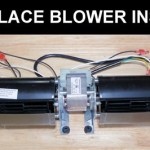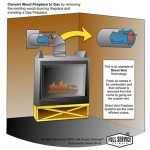Venting a Portable Air Conditioner Through a Fireplace: Considerations and Best Practices
The summer heat can be brutal, and for individuals lacking central air conditioning, portable air conditioners offer a viable solution. These units are relatively inexpensive, easy to install, and can cool a specific room effectively. However, a crucial aspect of using a portable air conditioner is proper venting. The unit expels hot air during the cooling process, and this air needs to be directed outside. One potential venting option that some consider is utilizing an existing fireplace. This article explores the feasibility and potential drawbacks of venting a portable air conditioner through a fireplace, providing insights for informed decision-making.
The primary function of a portable air conditioner is to draw in warm air from the room, cool it using a refrigerant cycle, and then exhaust the resulting hot air outside. Without proper venting, the expelled hot air will simply recirculate within the room, rendering the air conditioner ineffective and potentially increasing the overall temperature. Most portable air conditioners come with a venting kit that includes a hose designed to be connected to a window opening. However, some users explore alternative venting methods, including using a fireplace, driven by factors such as window limitations or aesthetic preferences.
Potential Benefits of Using a Fireplace for Venting
The appeal of venting through a fireplace often stems from its seemingly convenient pre-existing opening to the outside. Under ideal circumstances, this approach could offer several advantages. One potential benefit is the elimination of the need to modify a window. Many portable air conditioners require a window kit that partially blocks the window opening to accommodate the venting hose. Using a fireplace obviates the need for this alteration, preserving the window's view and functionality. Moreover, some individuals find the appearance of a venting hose sticking out of a window to be unsightly. Venting through a fireplace can provide a more discreet and aesthetically pleasing solution. Finally, the fireplace flue, when properly functioning, represents a direct pathway to the exterior, potentially streamlining the venting process.
However, it's crucial to understand that these are potential benefits that are highly dependent on the specific fireplace setup and diligent preparation. The reality of venting through a fireplace is often more complex and fraught with potential problems.
Key Risks and Challenges Associated with Fireplace Venting
While conceptually appealing, venting a portable air conditioner through a fireplace presents numerous risks that must be carefully considered. The most significant concern revolves around flue functionality and potential backdrafting. Fireplace flues are designed to expel smoke and combustion gases upwards, relying on the principle of thermal buoyancy – hot air rises. A portable air conditioner, however, is simply expelling hot air without the driving force of combustion. This means there is a significantly higher risk of the hot air being drawn back into the room, especially if the flue is not properly sealed or if there are downdrafts.
Moreover, many fireplaces are not airtight. Gaps and cracks in the firebox, flue, or damper can allow the hot air being expelled by the air conditioner to leak back into the room. This negates the cooling effect and potentially causes the air conditioner to work harder, increasing energy consumption and potentially shortening its lifespan. Unlike a sealed window vent, a fireplace is generally not designed for the constant and unidirectional expulsion of hot air associated with air conditioning. Older fireplaces, in particular, are often poorly sealed and prone to leakage.
Another critical factor is the presence of creosote. Creosote is a flammable substance that accumulates in the flue during wood-burning fires. While the hot air from a portable air conditioner is not directly combustible, the presence of creosote poses a fire hazard. The prolonged exposure to warm, moist air can potentially exacerbate existing creosote issues or create conditions conducive to its further accumulation. Furthermore, introducing warm, moist air into a flue designed for dry, hot exhaust can potentially lead to accelerated deterioration of the chimney structure. Moisture can combine with creosote to form corrosive compounds that can damage the flue lining.
In addition to the technical challenges, there are also practical considerations. Connecting the air conditioner's venting hose to the fireplace opening often requires custom fabrication or modifications. Standard venting kits are designed for window installations and may not readily adapt to the dimensions and shape of a fireplace opening. This can necessitate the use of makeshift adapters or the purchase of specialized components, adding to the overall cost and complexity. The aesthetics, which are often a motivator for considering fireplace venting in the first place, can also be compromised by a poorly executed adapter setup. The appearance of a hose awkwardly connected to the fireplace may be less desirable than a window vent.
Best Practices and Precautions for Venting Through a Fireplace
If, after carefully weighing the risks, an individual chooses to vent a portable air conditioner through a fireplace, it is imperative to take several precautions to mitigate potential problems. The first and most crucial step is to thoroughly inspect and clean the fireplace and flue. A professional chimney sweep should be hired to remove any accumulated creosote and assess the structural integrity of the chimney. Any cracks or gaps in the firebox, flue, or damper must be properly sealed to prevent backdrafting and air leaks. This may involve patching mortar, applying specialized sealant, or even replacing damaged components.
Next, a secure and airtight connection between the air conditioner's venting hose and the fireplace opening must be established. This often requires custom fabrication of an adapter plate that fits snugly into the fireplace opening and provides a secure attachment point for the hose. The adapter plate should be made of a non-combustible material such as sheet metal and should be properly insulated to prevent heat transfer. The connection between the hose and the adapter plate should also be airtight to prevent hot air from leaking back into the room. Duct tape alone is not an adequate solution; a more robust clamping mechanism is recommended.
Furthermore, it is essential to monitor the performance of the air conditioner and the fireplace carefully after installation. Observe the airflow from the vent to ensure that the hot air is being effectively expelled. Check for any signs of backdrafting, such as a noticeable increase in room temperature or the smell of stale air. Regularly inspect the fireplace opening and flue for any signs of condensation or accelerated deterioration. If any problems are detected, the venting setup should be re-evaluated and modifications made as necessary. Consider installing a carbon monoxide detector in the room as an added safety precaution.
It’s important to acknowledge that even with meticulous preparation, venting a portable air conditioner through a fireplace may not be an optimal solution. The potential for backdrafting, air leaks, and chimney deterioration remains a concern. Window venting, while potentially less aesthetically pleasing, is generally a safer and more efficient option. Before committing to fireplace venting, consider all alternative venting methods and consult with a qualified HVAC professional or chimney sweep.
The effectiveness of venting through a fireplace also greatly depends on the type of fireplace. A traditional masonry fireplace is often less airtight than a modern prefabricated fireplace insert with a sealed combustion system. Prefabricated inserts are designed for higher efficiency and better control over airflow, which may make them slightly more suitable for venting a portable air conditioner. However, even with a prefabricated insert, the same precautions regarding sealing and monitoring still apply.
Moreover, the length and configuration of the venting hose can impact the air conditioner's performance. A longer hose creates more resistance to airflow, which can reduce the cooling efficiency of the unit. Avoid unnecessary bends or kinks in the hose, and keep the hose as short as possible while still allowing for proper venting. Consider using an insulated hose to minimize heat loss during the venting process. The insulation can help to maintain the temperature of the expelled air, reducing the likelihood of condensation and improving overall efficiency.
Finally, comply with all local building codes and regulations. Some jurisdictions may have restrictions on venting appliances through fireplaces, particularly if the fireplace is located in a multi-family dwelling. Consult with local authorities to ensure that the venting setup is compliant with all applicable codes and regulations. Failure to comply with these regulations can result in fines or legal penalties.

Air Conditioner In Fireplace How To Install

How To Install A Portable Air Conditioner 10 Steps

How To Vent Your Portable Air Conditioner Through The Fireplace Instead Of A Window Ofl 1578

How To Vent Your Portable Air Conditioner Through The Fireplace Instead Of A Window Ofl 1578

How To Vent A Portable Air Conditioner Sylvane

How To Vent A Portable Air Conditioner Without Window American Home Water

How To Vent A Portable Air Conditioner Without Window

How To Vent A Portable Air Conditioner Without Window Bougerv

How To Vent A Portable Air Conditioner Without Window
Steve In A Sdo Gross Friday Funny 1432 Home Inspection Fails
Related Posts








